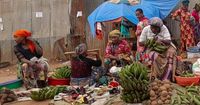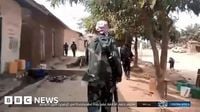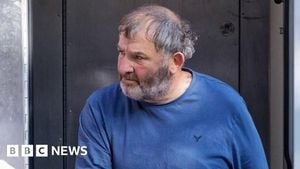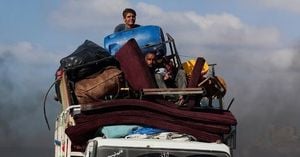In the early hours of September 9, 2025, the village of Ntoyo in North Kivu, eastern Democratic Republic of the Congo, became the site of one of the deadliest attacks in the region’s recent memory. According to multiple reports from The Associated Press, BBC News, and local sources, at least 60 people were killed—though some estimates run even higher—when rebels affiliated with the Islamic State group, specifically the Allied Democratic Forces (ADF), descended on a funeral ceremony and unleashed a wave of violence that has shocked the nation and the international community alike.
The attack, which took place after residents gathered to mourn at a burial, saw most of the victims hacked with machetes in a brutal night-time assault. Some were reportedly shot, and local broadcasters described scenes of “utter carnage,” with several bodies found burnt in their homes. A survivor, who requested anonymity out of fear of reprisal, recounted the horror to The Associated Press: “There were about 10 of them. I saw machetes. They told people to gather in one place and started cutting them. I listened to people screaming and I fainted.”
Official estimates of the death toll vary. While The Associated Press and the local administrator of Lubero territory, Col. Alain Kiwewa, initially put the figure at around 60, he cautioned that “the final toll will be given later this evening because the territory has just deployed services to the area to count the number of beheaded people.” Macaire Sivikunula, another local administrator, told Reuters that the provisional death toll stood at 50, but others on the ground feared the number could be even higher. Parish priest Paluku Nzalamingi, who visited the scene early Tuesday, told Actualite.cd: “They killed almost everyone who was gathered at the funeral home. In any case, many were shot dead. Bodies are on the road, in plots near the centre of Ntoyo. I haven’t been able to count them, but it’s more than 70 people, at least, is what I can say. Mostly killed by bullets.”
Adding to the confusion, one resident involved in the search for bodies claimed that as many as 102 people may have been killed, though this figure could not be independently verified by Anadolu or other administrative sources. The Islamic State’s Central African Province, to which the ADF is affiliated, claimed responsibility for the attack and asserted that more than 100 people had been killed. This figure was echoed by a local broadcaster, Mishapi Voice Radio, which quoted witnesses describing the “utter carnage” that engulfed the village.
The ADF, originally formed in Uganda in the 1990s, has long accused the Ugandan government of persecuting Muslims and has since established a foothold in eastern Congo, exploiting the region’s chronic instability and porous borders. Over the past several years, the group has intensified its activities, carrying out deadly attacks that have targeted both security forces and civilians, often in rural and vulnerable communities. Despite joint military operations by Congo and Uganda aimed at dismantling the group, the ADF has proven resilient and, in recent years, has pledged allegiance to the Islamic State group, further amplifying its reach and brutality.
This latest massacre is far from an isolated incident. In July 2025, the ADF carried out two major attacks in Ituri province: one at a church in Komanda, where at least 34 people were killed during a night vigil, and another in Irumu that claimed 66 lives. According to BBC Monitoring, nearly 90% of Islamic State operations are now conducted by affiliates based in Africa, with the ADF playing a prominent role in this expansion. The growing strength and frequency of these attacks have raised alarm bells among regional and international observers, who fear that the insurgency is gaining momentum.
The situation in eastern Congo is further complicated by the presence of multiple armed groups, including the Rwanda-backed M23 rebels, who are locked in a separate conflict with the central government. The Congolese military’s efforts to combat the ADF have been hampered by the need to deploy troops across different fronts, leaving many border villages like Ntoyo dangerously exposed. As a result, civilians have often found themselves caught in the crossfire, bearing the brunt of the violence.
At a United Nations Human Rights Council session in Geneva on Tuesday, U.N. High Commissioner for Human Rights Volker Türk addressed the deteriorating security situation, noting that the ADF had “taken advantage of the security vacuum.” This vacuum, created by the redeployment of government troops to other hotspots, has allowed the group to strike with impunity, further destabilizing an already fragile region.
The stories emerging from Ntoyo are harrowing. Survivors describe being rounded up by attackers wielding machetes, forced to witness the slaughter of their friends and family. Some managed to escape by hiding in the surrounding bush, while others were not so fortunate. The aftermath has left the village in mourning, with bodies still being recovered from homes and along the roads. The humanitarian implications are profound: families have been shattered, children orphaned, and the local community traumatized.
Despite the scale of the tragedy, the response from both national and international actors has been hampered by the region’s remoteness and the persistent threat posed by armed groups. Humanitarian agencies have struggled to access affected areas, while local authorities continue to grapple with the daunting task of identifying victims and providing support to survivors. The Congolese government, for its part, has vowed to intensify its efforts to root out the ADF and restore security to the region, but the challenges are immense.
The attack in Ntoyo is a grim reminder of the persistent insecurity that plagues eastern Congo, where decades of conflict, weak governance, and external interference have created a fertile ground for armed groups to thrive. For the people of Ntoyo and countless other communities across North Kivu and Ituri, the path to peace remains uncertain. As the international community watches with growing concern, the need for coordinated action—both to address the immediate humanitarian crisis and to tackle the root causes of the violence—has never been more urgent.
In the coming days, the full extent of the tragedy in Ntoyo will become clearer as authorities continue their grim task. But for many, the scars left by this latest atrocity will linger long after the world’s attention has moved on.






